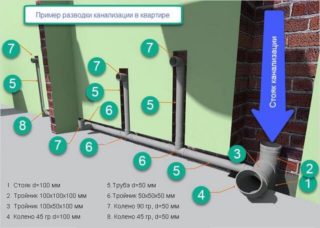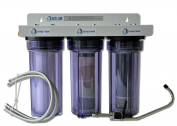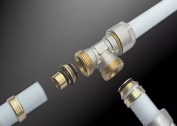Without exception, the parameters of the communication networks of residential and industrial premises are governed by the requirements of SNiP “External sewage and water supply networks”. New buildings are built on the basis of working and design documentation, technical data that can realize even the most unusual ideas. Other engineering lines located nearby are also taken into account to exclude the possibility of undermining nearby foundations.
General provisions of the joint venture external water supply and sewerage networks
 The main objective of the water supply and sanitation system is the continuous supply of water to buildings and waste management.
The main objective of the water supply and sanitation system is the continuous supply of water to buildings and waste management.
JV water supply: external networks and facilities
Sources of clean water are groundwater or water bodies. According to SNiP 2.04.03. You can use the following list of materials for installing a water supply system:
- glass pipelines are used, but rarely;
- polypropylene, polyethylene and PVC;
- for pipes of large cross-section, reinforced concrete and asbestos-cement.
To equip wells and wells, plastic and reinforced concrete are used.
Types of sewer systems
Sewerage is a whole network of pipelines that was built by engineers for the disposal and cleaning of dirty wastewater. At the design stage, standards and norms of SNiP are taken into account, based on the geological structure of the terrain and the regulations for laying pipes.
 The choice of a method for discharging contaminated water includes a number of options:
The choice of a method for discharging contaminated water includes a number of options:
- External centralized communication. For the installation of the network, you will first need to create a project in compliance with all technical conditions and obtain a certified permit for the system. A prerequisite is the establishment of communications with strict adherence to all safety standards and under the supervision of employees of the relevant authorities. The presence of a storage tank.
- Sealed containers are used to conduct an autonomous sewage system in homes with small families. Regularly cleaning the tank is required, therefore, free passage of sewage trucks or sewage pumps should be provided in the yard. The tanks are additionally equipped with an overflow control sensor.
- It is recommended to install a septic tank if the volume of effluents is small (25-50 cubic meters per day). Visually, it looks like an underground sump for sewage that enters there through a pipeline from an internal sewage network in the house. In the sump, all waste is divided into three layers: the sediment falls down, then a greasy film and clarified liquid, which penetrates the drainage system for cleaning and penetration into the soil. The septic tank needs to be installed at a distance of 5-20 meters from the house, this helps to prevent the negative impact of wastewater on the foundation of the structure.
32.13-330.1212 (SP) states that sewer systems are classified according to the source of wastewater. Each variety has its own individual characteristics, so you need to be able to correctly distinguish them. There are production, rain and rain, domestic and household.
The updated version of SNiP 2.04.03 indicates that local and centralized sewer networks do not have technical differences, with the exception of the amount of utilized waste. The document is freely available on the official website of the Ministry of the Russian Federation.
When assessing the possibility of water supply consumption, the following should be considered:
- the possibility of artificial addition;
- estimated water consumption for the next 15-20 years;
- floods;
- forecasts for a possible change in water quality as sewage penetrates.
When carrying out construction work on laying a drain, it is important to pre-execute all the documentation, provide drawings in accordance with all GOSTs.
Pipeline installation
 The rules for laying sewage pipes are specified in the regulatory document SNiP 20.40-385, published on the official website of the RF Ministries.
The rules for laying sewage pipes are specified in the regulatory document SNiP 20.40-385, published on the official website of the RF Ministries.
- When laying a pipeline network with a corrosion-resistant coating, soft grips and special protective devices must be used.
- Bell-shaped pipelines of a non-pressure system should be installed upward under a slope.
- Before embarking on a construction project, all drawings and technical calculations should be checked and approved by the relevant authorities. The results of the inspection and approval for the construction are recorded in a special logbook.
- In the presence of rectilinear joints, the ends of adjacent pipes must be centered so that the width of the gaps has the same parameters around the entire circumference.
- The horizontal position of the drainage non-pressure pipelines between adjacent systems is viewed using a mirror.
- The end of the flange gaps and pipes of locking reinforcing parts during intermittent installation is closed with wooden plugs or special plugs.
If one of the above rules is not observed, the corresponding documentation will not be issued.
Design and installation of sewer system
Installation of the sewer network begins with the discharge of wastewater from the inside of the apartment building or any other building. At the exit from the structures, sewage penetrates into wells, wells, which serve as an intermediate link between fan pipes and other elements of the pipeline.
The sewer system is not allowed:
- without pumping stations for additional pumping;
- without laying pipes of different diameters;
- without local installations designed to clean the system, for example, an aerator, septic tank.
The main condition for laying the highway is continuous operation, minimizing costs and the ability to regulate the pressure.
In this regard, SNiP included a number of additional aspects:
- population size in the area where it is planned to lay a water supply system;
- external factors - the presence of additional sources of water: rivers, lakes, ponds;
- landscape gardening;
- design of the object and features of its device on paper.
In the event of a breakdown, it should be possible to drive working equipment.
Piping system
Installation of the internal pipeline according to SNiP is as follows:
- in floor screed;
- using strobe, levels;
- wiring under the baseboards of the walls.
The presence of a slope at the beginning of the highway will allow the network to work quickly, as well as continuously dispose of household waste. The exception is the mountainous terrain, in this case, the use of special fecal pumps that push fecal masses and other waste into the pipeline system, which is placed at an angle, is relevant.
Pumps are necessary for the formation of a multi-stage pump system that allows not only to design, but also to lay the water supply system and sewage system in any relief terrain.
After collection, the waste fluid enters the sewer branches and moves towards aeration stations and treatment facilities. There, under the influence of chemicals, fermentation and decomposition of the contents takes place.
Rules for laying water supply networks
 When designing and erecting external trunk networks to provide residents with water, the following rules must be observed:
When designing and erecting external trunk networks to provide residents with water, the following rules must be observed:
- Projects of water supply, sanitation and sewage lines should be carried out in parallel.
- The quality of clean water must comply with all regulations and SanPiN standards.
- The operating temperature in the external line should fluctuate between + 2-25 degrees, hot ducts should be in the range + 50-75 degrees.
It is also worth mentioning the requirements for installing reinforcing elements.
- Joints are welded between adjacent parts only after complete and thorough tightening of the bolted joints located on the flanges.
- Flanges must be joined at right angles (90 degrees) with respect to the axis of the pipes.
- A common problem is misalignment of flanges. There are several solutions to the problem, but you should refrain from using gaskets and tightening clamps.
- Joint flanges should not have errors, bolts are tightened with one of all possible options - crosswise, and nuts should be placed on one side of the joints.
The JV “External Sewerage and Water Supply Networks” includes pipe laying and drilling requirements, well upgrading in accordance with all technical requirements. However, due to rapidly developing technologies, it is possible that in the near future new types of backbone networks will appear, as well as new technologies for their arrangement. This prompts new amendments to the design and installation of communication networks in the relevant documentation.
When designing communications, you must give preference to trusted organizations and highly qualified design engineers. Saving on good specialists can significantly increase the allowable cost item. It is also necessary to correctly compile and execute all the documentation, since illegal actions can lead to a fine and seizure of real estate.


